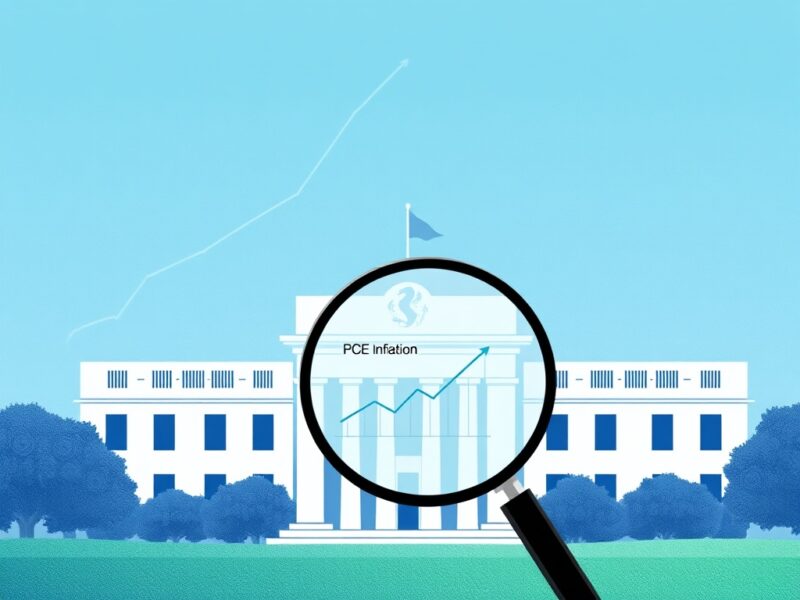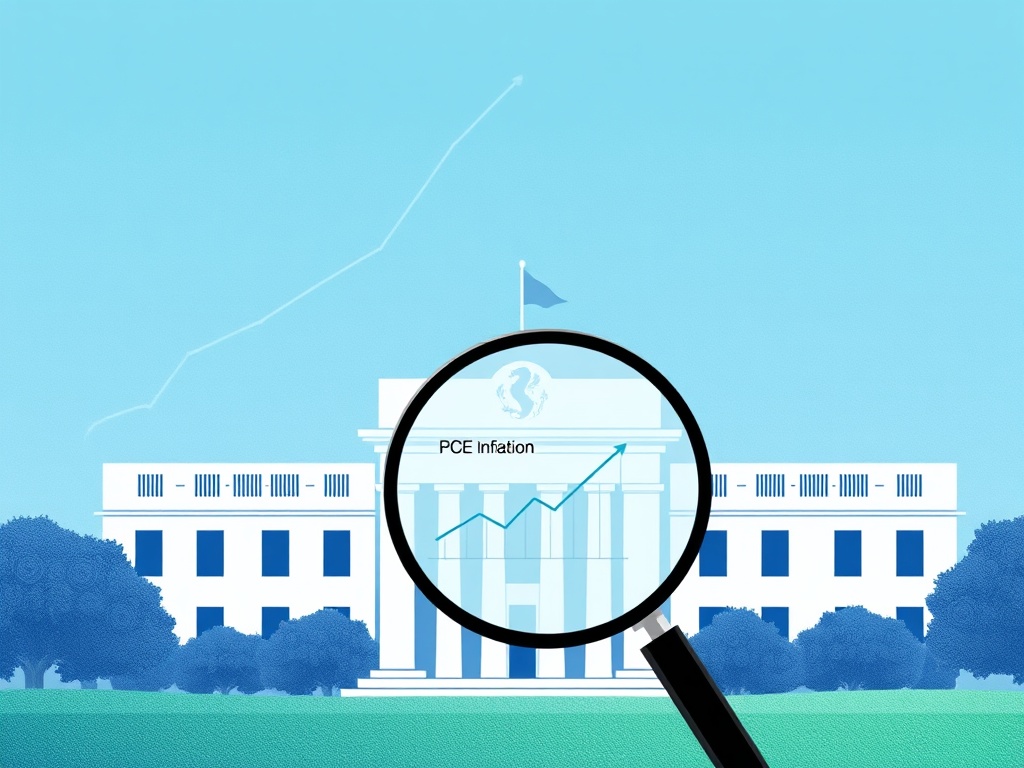Forex Market Dynamics: Asia FX Braces for Impact as Fed Rate Cut Bets Intensify
0
0

BitcoinWorld

Forex Market Dynamics: Asia FX Braces for Impact as Fed Rate Cut Bets Intensify
In the interconnected world of finance, movements in traditional markets often send ripples across the burgeoning cryptocurrency landscape. Investors keenly watch major central bank decisions, especially those impacting the Forex market dynamics, as they dictate global liquidity and risk appetite. Currently, the spotlight is firmly on the Federal Reserve and its potential interest rate path, which is causing palpable anticipation across Asia’s currency markets. Understanding these traditional financial shifts is not just for conventional traders; it provides crucial context for anyone navigating the volatile world of digital assets, influencing everything from stablecoin demand to overall market sentiment.
What Are Fed Rate Cut Bets Telling Us About Global Markets?
The global financial community is fixated on the Federal Reserve’s next move regarding interest rates. For months, market participants have been placing significant Fed rate cut bets, anticipating a pivot from the aggressive tightening cycle seen over the past couple of years. This expectation has been a primary driver for currency movements, equity valuations, and even the broader sentiment in risk assets, including cryptocurrencies. The narrative around when and by how much the Fed will cut rates is complex, influenced by a myriad of economic indicators.
Initially, there was strong conviction for multiple rate cuts starting early in the year. However, recent robust economic data from the US, particularly in employment and consumer spending, has tempered these expectations. This resilience has led to a recalibration of market forecasts, pushing back the projected timeline for the first rate cut and reducing the number of cuts anticipated for the year. This shift has significant implications:
- Stronger Dollar: When the prospect of US rate cuts diminishes, the dollar tends to strengthen as its yield advantage remains attractive. This makes dollar-denominated assets, including some cryptocurrencies, relatively more expensive for international buyers.
- Reduced Risk Appetite: Delayed rate cuts can signal a ‘higher for longer’ interest rate environment, which generally dampens investor enthusiasm for riskier assets. This can lead to capital outflows from emerging markets and a more cautious approach to volatile sectors like crypto.
- Bond Market Volatility: Shifting rate expectations introduce volatility in bond markets, impacting borrowing costs for governments and corporations worldwide.
The uncertainty surrounding these Fed rate cut bets creates a challenging environment for investors, demanding careful analysis of every data point and central bank communication. The stakes are high, not just for the US economy, but for global financial stability and the trajectory of capital flows.
Decoding US PCE Inflation: Why It Matters for Asia FX
Among the critical economic indicators influencing the Federal Reserve’s decisions, the Personal Consumption Expenditures (PCE) price index stands out. The Fed explicitly states that PCE is its preferred measure of inflation, making its release a highly anticipated event. Understanding US PCE inflation is paramount for anyone tracking the Fed’s monetary policy and, by extension, its impact on Asia FX performance.
Why is PCE so important?
- Comprehensive Measure: PCE covers a broader range of goods and services than the Consumer Price Index (CPI) and adjusts for changes in consumer behavior, making it a more accurate reflection of actual spending patterns.
- Core Focus: The ‘core’ PCE, which excludes volatile food and energy prices, is particularly scrutinized as it provides a clearer picture of underlying inflationary pressures. The Fed’s long-term target for core PCE is 2%.
- Policy Driver: Deviations from the 2% target directly influence the Fed’s stance on interest rates. If PCE remains elevated, it reduces the likelihood of rate cuts; if it shows a sustained decline towards the target, it strengthens the case for easing monetary policy.
Upcoming PCE data releases are therefore pivotal. A higher-than-expected reading would likely reinforce the ‘higher for longer’ narrative, boosting the US dollar and potentially putting downward pressure on Asian currencies. Conversely, a softer PCE report could reignite rate cut expectations, weakening the dollar and offering some relief to Asia FX performance. The sensitivity of the Forex market to this data cannot be overstated.
Here’s a snapshot of recent PCE inflation trends:
| Indicator | Latest Reading (YoY) | Previous Reading (YoY) | Fed Target |
|---|---|---|---|
| Headline PCE | 2.7% | 2.5% | 2.0% |
| Core PCE | 2.8% | 2.8% | 2.0% |
These figures illustrate the persistent challenge the Fed faces in bringing inflation sustainably back to its target, directly impacting the timing of any Fed rate cut bets.
How Does Asia FX Performance Navigate Global Headwinds?
The Asian currency market, often referred to as Asia FX performance, is a complex tapestry influenced by both global macro trends and specific regional dynamics. When the US dollar strengthens due to hawkish Fed expectations, Asian currencies generally face depreciation pressure. This is a significant headwind for economies that rely on imports priced in dollars or have substantial dollar-denominated debt.
Consider some key Asian currencies:
- Japanese Yen (JPY): Often seen as a safe-haven currency, but recently it has been under pressure due to the Bank of Japan’s ultra-loose monetary policy, contrasting sharply with the Fed’s higher rates. This divergence has led to significant yen weakness.
- Chinese Yuan (CNY): Managed by the People’s Bank of China, the yuan’s stability is crucial for global trade. Its movements are closely watched, as a weaker yuan could signal economic challenges in China, impacting regional trade and investment.
- Korean Won (KRW): Highly sensitive to global trade and technology cycles. A strong dollar and slower global growth can weigh heavily on the won.
- Indian Rupee (INR): Often supported by robust domestic demand and foreign direct investment, but vulnerable to oil price fluctuations and capital outflows during periods of global uncertainty.
- Indonesian Rupiah (IDR): A commodity-linked currency, also sensitive to capital flows. Higher US rates can make it less attractive for foreign investors.
Challenges for Asia FX performance include:
- Capital Outflows: A stronger dollar and higher US yields can attract capital away from Asian markets, leading to currency depreciation.
- Imported Inflation: Weaker local currencies make imports, especially essential commodities like oil, more expensive, contributing to domestic inflation.
- Export Competitiveness: While a weaker currency can boost exports, the benefits can be offset by higher import costs for raw materials and components.
The interplay between US monetary policy, US PCE inflation, and regional economic fundamentals creates a volatile environment for Asian currencies. Central banks in Asia often face the difficult task of balancing domestic growth with currency stability, sometimes resorting to intervention to smooth out excessive volatility.
The Ripple Effect: Global Monetary Policy and Currency Volatility
The Federal Reserve’s decisions are not made in a vacuum. They form a critical part of a broader landscape of global monetary policy, where central banks around the world navigate their own economic conditions while reacting to international spillovers. The divergence or convergence of these policies significantly impacts currency valuations and international capital flows.
For example, while the Fed has maintained a relatively hawkish stance, other major central banks have taken different paths:
- European Central Bank (ECB): Has also been fighting inflation but might be closer to its own rate-cutting cycle than the Fed, potentially leading to euro weakness against the dollar.
- Bank of Japan (BoJ): Only recently exited its negative interest rate policy, but remains far more dovish than other major central banks, contributing to the persistent weakness of the Japanese Yen.
- People’s Bank of China (PBOC): Has been easing monetary policy to support its economy, contrasting with the tightening cycles elsewhere, which puts pressure on the yuan.
This mosaic of global monetary policy creates a complex environment for currency traders and investors. Carry trades, where investors borrow in a low-interest-rate currency and invest in a high-interest-rate currency, become more attractive when policy divergence is wide. However, these trades are also highly sensitive to shifts in rate expectations, making them risky.
Actionable insights for tracking global monetary policy:
- Monitor Central Bank Communications: Speeches, press conferences, and meeting minutes provide invaluable clues about future policy direction.
- Track Economic Data Releases: Inflation, employment, and GDP figures from major economies are key drivers of central bank decisions.
- Observe Interest Rate Differentials: The gap between interest rates in different countries is a primary determinant of currency strength and capital flows.
The collective actions of these central banks define the overall liquidity conditions in the global financial system, which in turn influences the demand for various asset classes, including digital currencies. Understanding these forces helps anticipate broader market movements.
Navigating Forex Market Dynamics: Strategies for the Road Ahead
Given the prevailing uncertainty around Fed rate cut bets and the critical role of US PCE inflation, navigating the current Forex market dynamics requires a blend of caution and strategic positioning. For both traditional investors and those in the crypto space, understanding these currency movements is essential, as they often signal shifts in global risk sentiment and capital allocation.
Here are some strategies and considerations for the road ahead:
- Stay Informed on Data: The most immediate impact on currency markets comes from economic data. Pay close attention to US inflation reports (PCE, CPI), employment figures, and GDP growth. Similarly, monitor key economic indicators from major Asian economies to gauge their domestic resilience.
- Watch Central Bank Rhetoric: Beyond data, the language used by central bank officials can significantly move markets. Look for subtle shifts in tone regarding inflation, growth, and policy outlooks.
- Assess Risk Sentiment: During periods of heightened uncertainty, investors often flock to safe-haven assets like the US dollar or gold, while riskier assets (including many cryptocurrencies and some Asian currencies) may see outflows. Understanding the prevailing risk appetite is crucial.
- Diversify Portfolios: In a volatile environment, diversification across different asset classes and geographies can help mitigate risk. For crypto investors, this might mean balancing holdings with exposure to less correlated assets.
- Consider Hedging Strategies: Businesses and investors with exposure to foreign currencies might consider hedging strategies to protect against adverse currency movements.
- Focus on Fundamentals: While short-term movements are driven by headlines, long-term currency trends are anchored in economic fundamentals. Look for economies with strong growth prospects, manageable debt, and sound fiscal policies.
The current environment is characterized by a delicate balance between persistent inflation and potential economic slowdowns. This makes the job of central bankers, particularly the Federal Reserve, incredibly challenging, and their decisions will continue to be the primary catalyst for Forex market dynamics. For investors, agility and a deep understanding of these intertwined forces will be key to successful navigation.
Conclusion: Awaiting Clarity in a Volatile World
The global financial landscape remains on edge, with Asia FX performance particularly susceptible to the ongoing debate surrounding Fed rate cut bets and the trajectory of US PCE inflation. The intricate web of global monetary policy decisions continues to shape Forex market dynamics, creating both challenges and opportunities for investors worldwide. As we await clearer signals from the Federal Reserve, the emphasis on robust economic data and cautious central bank communication will only intensify. Staying informed and adaptable will be crucial for navigating these uncertain times, ensuring that investment strategies, whether in traditional currencies or digital assets, are resilient to the shifting tides of global finance.
To learn more about the latest Forex market trends, explore our article on key developments shaping interest rates and global liquidity.
This post Forex Market Dynamics: Asia FX Braces for Impact as Fed Rate Cut Bets Intensify first appeared on BitcoinWorld and is written by Editorial Team
0
0
 Manage all your crypto, NFT and DeFi from one place
Manage all your crypto, NFT and DeFi from one placeSecurely connect the portfolio you’re using to start.




